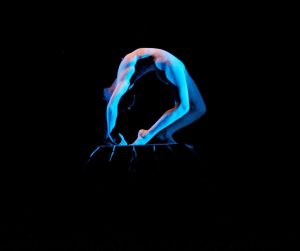

In Greek mythology, Hades kidnaps Persephone, daughter of Zeus and Demeter, goddess of the harvest, and makes her queen of the underworld. She is abducted by her uncle with her father’s consent – according to the ancient Greeks, nothing happens in this world without Zeus’s approval -- and without her mother’s knowledge. The story poses the question: can there be a more perfect hell for a woman? A woman who, for all intents and purposes, is still a child.
This ancient myth serves as the inspiration and backbone for “B. Madonna”, a brilliant dance performance piece choreographed and directed by Maureen Fleming and performed by Fleming and Christopher Odo, with music by Philip Glass. In Fleming’s expressionist treatment, the narrative is fleshed out in a series of nine solo dances, a few of which contain minute-long monologues relating to the choreographer’s own personal experience. For example, the program notes (essential for a deeper understanding of the piece) inform the reader that Fleming discovered that she had a bone spur between her fourth and fifth vertebrae, which may have been caused by a car accident when she was two years old. In the fifth dance, “Man on a Bicycle”, performed by Christopher Odo, the audience learns that an accident is caused by a man on a bicycle. In the sixth, that a child was thrown through a car windshield.
But “B. Madonna”, short for "Black Madonna", is fundamentally a visual experience. It contains faint echoes of Pilobolus’s early abstract pieces and is held together by an extreme, intellectual complexity and emotional intensity that is very rarely seen on a stage. The haunting beauty of the work, a dark metaphysical glimpse into the essence of violence and pain, is conveyed through Fleming’s reduction of the elements of the piece to the bare essentials: light, sound, purity of form, and reflection. Purity of form is Fleming’s forte, a fact emphasized by nudity. Her slow, contorted, exquisite movements -- her ability to create the illusion of flight (Fleming defies gravity!) -- create an otherworldliness that, naturally in this context, is the realm of the unreal, the unnatural, the hellish, and the emotional. It is the distillation of Persephone's experience. Fleming’s feminist vision of hell seduces the audience with an irresistible sensuousness and tranquility. But hell is hell no matter how beautiful you make it, and Fleming answers the feminist question that circles through the piece ('can there be a more perfect hell for a woman?') with another, more spiritual query: “Can the soul be transformed through the body?” The answer to this question, according to the performance, is “Yes, but only through the processes of pain.” That is Persephone's answer. A negative one would be meaningless.
“B. Madonna” is a powerful, transcendent and supremely beautiful work of art. But really, these words are almost inadequate. The ancients Greeks, who in addition to so many strange and wonderful myths gave the world the first conceptualization of aesthetics, believed that only the highest and most noble and profound works of art merited the description sublime. It is this word that best describes “B. Madonna.”